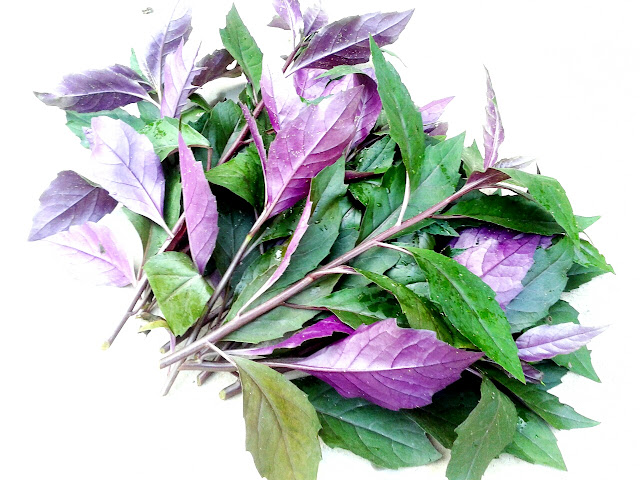Butterfly Pea ( Clitoria ternatea ) is an amazing herb that is frequently being drank as tea or used as natural food colouring in Southeast Asia.
In Thailand, ‘Nam dok anchan’, a commonly consumed refreshing indigo-blue drink, is made from Butterfly Pea flowers, honey and sugar syrup.
In traditional Thai cooking, Butterfly Pea flowers are squeezed for their blue extract, which is then mixed with coconut milk and other base ingredients to naturally colour Thai desserts in blue and purple.
In Burmese and Thai cuisines, the flowers are also dipped in batter and fried.
In Malay cooking, an aqueous extract is used to colour glutinous rice for ‘kuih ketan’ and in ‘nyonya chang’.
In Kelantan, east Malaysia, the locals add a few buds of this flower in a pot while cooking white rice to add a bluish tint to the rice known as ‘nasi kerabu’.
Aside from their numerous uses in colouring food and making tea, Butterfly Pea Flowers are also reputed for their many health benefits. Below, is a list them:
1) Improve eyesight
Clitoria Ternatea contains an antioxidant called proanthocyanidin, which increases blood flow to the capillaries of the eyes, useful in treatment of glaucoma, blurred vision, retinal damage or tired eyes.
2) Improve hair growth
Rich in bioflavonoids, Butterfly Pea can promote hair growth and reduce greying of hair.
3) Improve skin
Butterfly Pea’s antioxidants stimulate collagen and elastin synthesis, which helps rejuvenate the skin and lessen wrinkles and other signs of ageing.
4) Aphrodisiac
Butterfly Pea has been traditionally used as an aphrodisiac particularly for women and used to treat menstruation problems or white vaginal discharge (leucorrhoea).
5) Antioxidant
Flavonoids, anthocyanins and phenolic compounds in Butterfly Pea flowers activate antioxidant activity, which helps decrease oxidative stress caused by disease causing and ageing free radicals.
6) Nootropic
Butterfly Pea has been shown to enhance cognitive function and boost brain function.
7) Diuretic
Butterfly Pea promotes normal urination, which in turn lowers blood pressure
8) Analgesic
Clitoria Ternatea has been used traditionally as a local anaesthetic as it has been shown to help relieve pain and swelling.
9) Anxiolyhic
Butterfly Pea has a calming effect on the body, reducing stress and anxiety
10) Anti-inflammatory
The deep indigo flowers contain flavonoids. Found in almost all fruits and vegetables, flavonoids are powerful antioxidants with anti-inflammatory and immune system benefits.
11) Anti-Asthmatic
It is used in common cold, cough & asthma as it acts as an expectorant and reduces the irritation of respiratory organs.
12) Anti-anxiety and depression
Indications are that high doses of Butterfly Pea may be adaptogenic – helping the body deal with stressors.
13) Anti-diabetic
Butterfly Pea has shown to inhibit glucose intake from the diet.
14) Anti-HIV
Butterfly Pea is one of the few herbs to contain cyclotides, which have exhibited anti-HIV effects in studies.
15) Anti-cancer and anti-tumor
Clitoria Ternatea’s cyclotides can cause cancer cell death by disrupting cell membrane integrity.
16) Anti-microbial
In several Indian studies, Butterfly Pea exhibited significant anti-microbial effects against Staphylococcus Aureus.
17) Anti-convulsant
Butterfly Pea has been shown to help reduce the severity and stress on the body from convulsions useful in treating epilepsy.
18) Anti-pyretic
Clitoria Ternatea can help reduce fever by dilating the blood vessels right beneath the skin, whereby air can cool the blood easier.
To enjoy their many reputed health benefits or simply to release some stress, drinking Butterfly Pea Flower Tea may be simplest way.
Here is how you can prepare Butterfly Pea Flower Tea :
1) Simply steep 10 flowers, fresh or dried, in a cup of hot water, let sit 15 minutes.
2) When there is no colour left in the petal, strain the liquid and discard the flowers. You will be left with an amazing indigo-coloured broth.
3) Add some sugar if you prefer it sweet.
4) The tea is then, ready to be enjoyed.
Additional tips : Fresh or dried lemongrass can be added during steeping to improve its flavour. The tea can also be consumed with some drops of lime juice to create a sweet ‘n’ sour flavour and turn the luminous indigo to a deeper purple colour tea. Simply mixing the tea with fuchsia roselle hibiscus would turn the tea to a bright red colour.
Butterfly Pea flowers are usually quite
readily available to Malaysians. They are often found
sold fresh or
dried in many local
Malaysia wet markets. However, in countries where Butterfly Pea Plants are not usually cultivated, the dried form of flowers may also be quite easily available. All you have got to do is just a little bit of googling. There are plenty of online shops out there selling them.
Finally, should you want to learn about Butterfly Pea Plant and how to grow one, you can always have a read HERE.



































